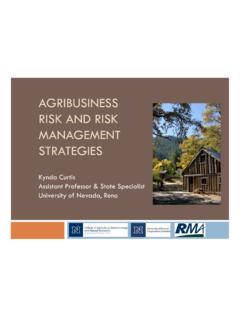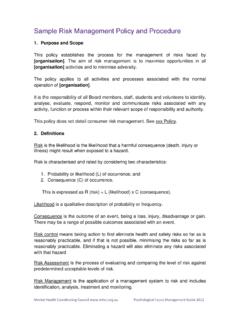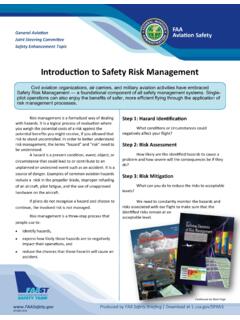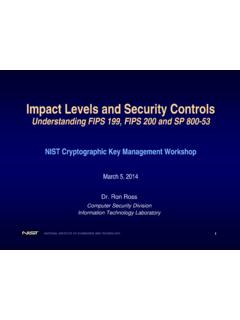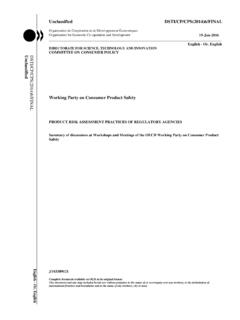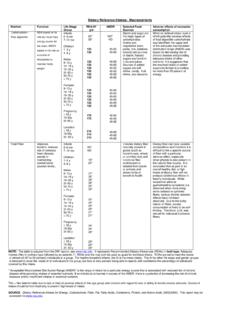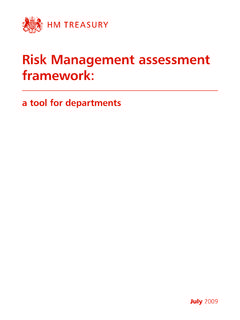Transcription of Enterprise Risk Management Policy and Procedures Manual
1 Note: This Policy is subject to final approval. Enterprise Risk Management Policy and Procedures Manual I. Policy Introduction The Board of Directors and Management of Lorenzo Shipping Corporation (LSC) consider risk Management as a central or integral part of the organization s strategic Management . It is the process whereby LSC methodically address the risks attaching to their activities with the goal of achieving sustained benefit within each activity and across the portfolio of all business activities. Risk Management is the culture, processes and structures that are directed towards realizing potential opportunities and managing adverse effects. It is a tool to help Management improve its decision-making process, minimize its losses, as well as maximize its profits.
2 It offers a framework or process for effectively managing uncertainties, responding to risks , and exploring opportunities as they arise to ensure that value is created, protected, and enhanced. The purpose of this risk Management procedure is to provide all personnel of Lorenzo Shipping Corporation with the skills to apply consistent and comprehensive risk Management methodology which includes how to identify, analyze, evaluate and control risks . The risk Management process contained in this Manual follows the COSO Enterprise Risk Management Framework. It is a continuous and developing process which runs throughout the organization s strategy and the implementation of that strategy. It should address methodically analyze all the risks surrounding the organization s activities in the past and present so we can learn from it and protect the future.
3 II. Definition of Terms Risk Management is the identification, assessment, and prioritization of risks followed by coordinated and economical application of resources to minimize, monitor, and control the probability and/or impact of unfortunate events or to maximize the realization of opportunities. A risk is an uncertain event that will have a negative impact on the achievement of a business objective. A control is a process, effected by an entity s board of directors, Management and other personnel, designed to provide reasonable assurance regarding the achievement of objectives. Inherent risk is a risk without regard to any Management action or controls to alter or change its nature or state. Residual risk is the remaining exposure after considering Management action or control to reduce the impact or likelihood of the risk.
4 A risk appetite is the level of risk the organization is willing to take in pursuit of value or to achieve a desired level of return or growth outcome. It can vary over time and from work to work area. The risk appetite must be articulated by the board and Management and must be communicated across the organization. Note: This Policy is subject to final approval. A risk tolerance is the acceptable levels of variation relative to the achievement of objective. III. Objectives of Risk Management Risk Management is a responsibility of all LSC employees, with specific risk responsibilities being allocated to different groups and levels within the organization. It is important to have complete and current risk information available as this information assists Management to make more informed decisions around both strategic direction and operational objectives.
5 Risk Management is not a stand-alone discipline but requires integration with existing business processes such as business and budget planning, in order to provide us with the greatest benefits. The objectives of a risk Management framework are to: Provide a systematic approach to the early identification and Management of risks ; Provide consistent risk assessment criteria; Make available accurate and concise risk information that informs decision making including business direction; Adopt risk treatment strategies that are cost effective and efficient in reducing risk to an acceptable level; and Monitor and review risk levels to ensure that risk exposure remains within an acceptable level. IV. Benefits of Risk Management Application of a consistent and comprehensive risk Management process will: Increase the likelihood of us achieving our strategic and business objectives; Encourage a high standard of accountability at all levels of the organization; Support more effective decision making through better understanding of risk exposures; Create an environment that enables us to deliver timely services and meet performance objectives in an efficient and cost effective manner; Safeguard our assets human, property and reputation; and Meet compliance and governance requirements.
6 V. Roles and Responsibilities Our ability to conduct effective risk Management is dependent upon having an appropriate risk governance structure and well-defined roles and responsibilities. Note: This Policy is subject to final approval. It is important for each LSC employee to be aware of his or her individual and collective risk Management responsibilities because it is not merely about having a well-defined process but also about effecting the behavioral change in each of us so risk Management is embedded in all organizational activities. Set out below is LSC s Risk Management Governance Structure. This structure illustrates that risk Management is not the sole responsibility of one individual but rather occurs and is supported at all organizational levels .
7 Risk Management Governance Structure Board of Directors Among other things, the Board of Directors should: - Establish the risk Management governance structure including clear delineation of authority and responsibility over risk Management at all levels across the organization; - Set the risk appetite and risk tolerances of specific business activities or projects of the organization; - Establish, communicate and commit to ethical values and code of conduct; - Build competence and develop people within the organization; - Establish risk Management framework, policies, and Procedures ; - Create risk awareness and training across the organization; - Have oversight with knowledge and understanding of critical risks ; - Periodically review Risk Management Policy /Strategy Formulation and Implementation; LSC Board of DirectorsAudit & Risk CommitteeLSC PresidentLORENZO SHIPPING CORPORATION (LSC)RISK Management GOVERNANCE STRUCTURERisk Management Executive CommitteRisk Management Group(Headed by Chief Risk Officer)LSC EmployeesNote: This Policy is subject to final approval.
8 - Define boundaries and limits that clearly exclude behaviors and actions that are off-strategy and unacceptable; - Encourage and reward growth and innovation without creating unacceptable exposure to risk; - Clarify, understand and manage risk appetite over the organization s opportunity-seeking behavior in developing new products and new markets; - Ensures that performance measures and targets do not encourage excessively risky behavior; - Take an Enterprise -wide view of risks , rather than a narrower unit or functional view, when selecting strategies to optimize risk and reward for the Enterprise as a whole; and - Obtain assurance that an effective internal controls and checks and balances are in place in high-risk areas. Risk Committee (RC) A board committee, either dedicated or one with other responsibilities, should assist the board to review risks , the risk Management process and the significant risks facing the company.
9 The Risk Committee, is composed of the following members from the Board of Directors: - Ms. Doris Magsaysay-Ho Chairman - Mr. Antony Loius L. Marden Member - Mr. Michael L. Escaler Member President The President together with the Board of Directors creates an environment for risk Management to operate effectively and, at the same time, ensuring that significant internal and external factors, including stakeholder interests, are considered in defining risk tolerance levels . The President act as: The comprehensive Risk Executive; The ultimate responsible for risk Management priorities, tolerance, policies and strategies; and The final Enforcer on such matter. Risk Management Executive Committee (RMEC) The RMEC has the overall responsibility for risk Management at the Enterprise Ievel, including: Strategic risk; Project risk; and Business or operational risks Note: This Policy is subject to final approval.
10 The RMEC shall appoint and mandate the members of the Risk Management Group and ensures that the risk Management policies, strategies and methodologies are developed and carried out in an effective and efficient manner. The RMEC is composed of the following company officers: - Mr. Romualdo L. Bea, VP - Chief Financial Officer Chairman - Mr. Jay R. Olivarez, Liner Group Chief Operating Officer Member - Mr. Roland J. Portes, VP - Operations (Liner Group) Member - Mr. Edralin G. Manapsal, VP - Sales and Marketing (Liner Group) Member Risk Management Group The Risk Management Group supports the RMEC in performing its responsibility in institutionalizing a sustainable risk Management process within the organization. - Chairman: Chief Risk Officer - Members: Cluster Finance and Accounting Manager, Legal Manager, Compliance Officer, HR and Corporate Service Head, Technology Solutions Manager, Corporate Strategy Head, Branch Coordinating Manager and Internal Audit Manager.
